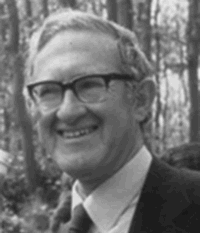
Mitch Lewis retired 20 years ago and will be remembered with affection by his contemporaries, old colleagues and the many clinicians he trained. He will however be known by many more as the co-author of the standard laboratory reference book ‘Practical Haematology’ which he produced with Professor Sir John Dacie. First published in 1950 it has served as a practical bench manual for many generations and it is fair to say that has been a ‘bible’ for haematology. The book is now in its 12th edition and continues their tradition of excellence.
He was a consultant haematologist at the Hammersmith Hospital where he worked his entire career and only retired from his emeritus position in 2010 due to chronic ill health. He was President of the British Society for Haematology in 1983–1984 and leaves a substantial body of work behind him, particularly in the late 1960s on the performance of haemoglobin measurement which led to the development of the haemoglobincyanide reference standard under the guidance of the International Committee for Standardisation in Haematology (ICSH). An organisation of which he was a founding member and second chairman from 1982 to 1994. He also co-founded the UK National External Quality Assurance Scheme (NEQAS) where he was Director until his retirement in the 1990s. He published his last paper in 2011 titled ‘ICSH review of the measurement of the erythrocyte sedimentation rate (ESR)’ in the International Journal of Laboratory Haematology. Once he had retired from his emeritus position the then Director (Professor Keith Hyde) established the Mitchell Lewis poster prize, which was given to the winning poster at the annual NEQAS Haematology Participants’ meeting.
Dr. Lewis attracted a large number of postgraduate students from all over the world, particularly from Europe, the Commonwealth countries and the Far East to study and learn the laboratory techniques at the Hammersmith, under his guidance and tutelage. He was always particularly generous with his time and developed many international friends through these links. This experience led to Mitch, in partnership with Victor Hoffbrand, to publish in 1972 a book called ‘Postgraduate Haematology’ which became the basic textbook for doctors revising for postgraduate examinations. It is presently in its 7th edition and remains a standard postgraduate text. Mitch was still actively writing as an editor up till the 1999 4th edition.
He also developed and taught the haematological curriculum for the Diploma in Clinical Pathology (DCP) at the Hammersmith Hospital, attracting a regular biennial group of postgraduate students, to study and learn their basic techniques allied to clinical practice.
Dr. Lewis, usually accompanied by his wife Ethel, travelled widely around the world throughout his career and paid special attention to the needs, capabilities and skills of haematologists and their support staff in the developing countries. He became actively involved with the WHO particularly in their aims to improve the diagnosis and management of general anaemia, especially in rural communities. After retirement, he continued to develop simple diagnostic tools with colleagues that could be utilised in lower and middle-income countries that lacked regular and reliable sources of electricity, water and reagents.
He was also a long-term supporter of the ISH acting for many years as a Councillor, and later Councillor at Large, for the Society and actively involved the British Society for Haematology in the work of the ISH. His life-long interest in the development of quality assurance in the haematology laboratory was a prime drive of his and he succeeded in getting the ISH recognised as an international force in the development of standards in haematology worldwide.
Mitch Lewis lived through and participated in massive changes in haematological medicine and while capable he continued to participate in developing laboratory practise worldwide to support widespread clinical activities. He has personally helped many physicians and scientists to practice better medicine. This has been a truly wonderful life-long achievement.
